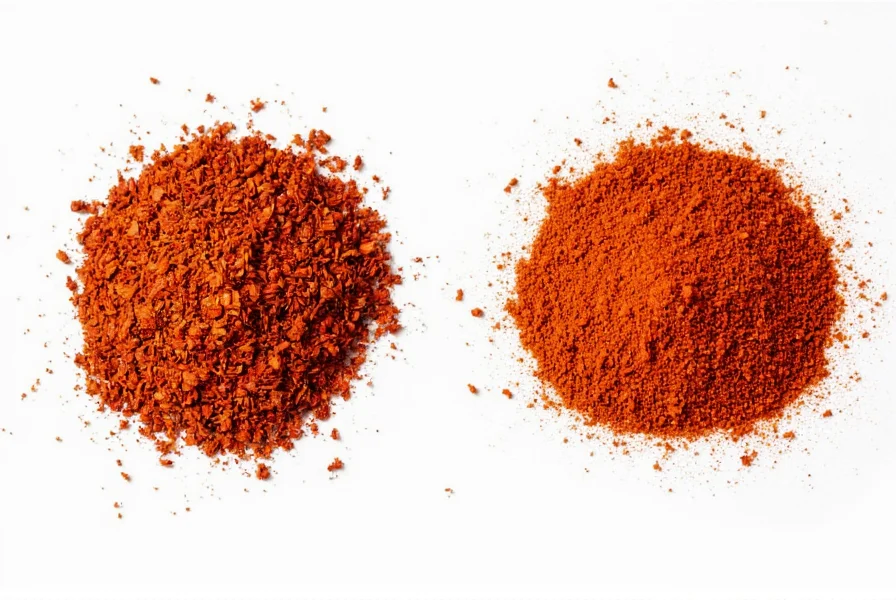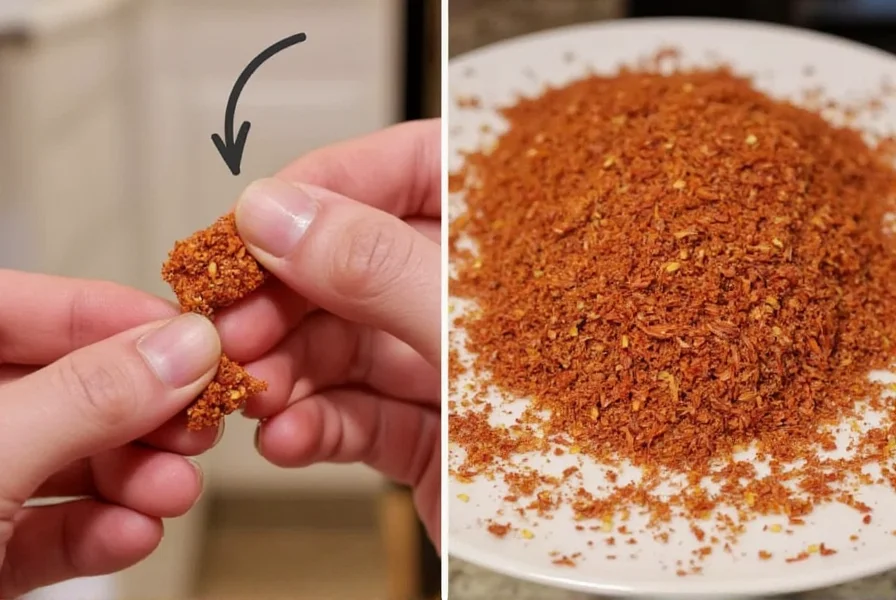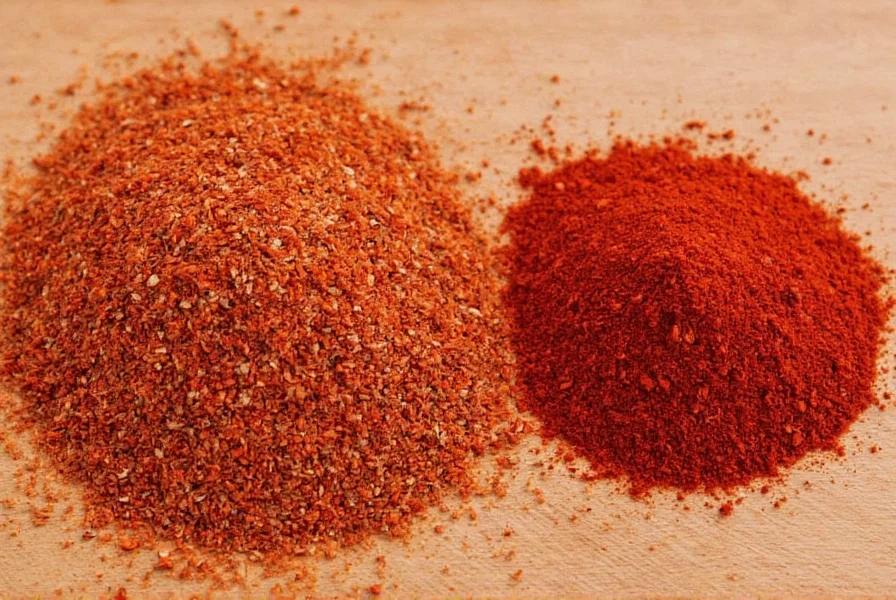Understanding the subtle yet important distinctions between red chili flakes and crushed red pepper can significantly impact your cooking results. While many grocery stores and recipes use these terms loosely, professional chefs and serious home cooks recognize that these two pantry staples behave differently when added to dishes.
Visual and Textural Characteristics
When comparing red chili flakes vs crushed red pepper side by side, the most immediate difference is in their physical appearance. Red chili flakes consist of larger, irregular fragments that often include seeds and membrane, creating a more rustic appearance. These flakes typically range from 1/8 to 1/4 inch in size with noticeable variation between pieces.

Crushed red pepper, by contrast, undergoes additional processing to achieve a more uniform consistency. The particles are smaller and more consistent in size, usually between fine powder and small granules. This processing often removes most seeds, resulting in a more homogeneous product that distributes heat more evenly throughout a dish.
Flavor and Heat Profile Comparison
The difference between red chili flakes and crushed red pepper extends to their flavor profiles and heat distribution. Because red chili flakes retain seeds and membrane (where capsaicin concentration is highest), they can deliver unpredictable heat levels—some flakes may be mild while others from the same container pack significant punch.
| Characteristic | Red Chili Flakes | Crushed Red Pepper |
|---|---|---|
| Particle Size | 1/8 to 1/4 inch, irregular | Fine to medium granules, uniform |
| Seed Content | Contains seeds and membrane | Most seeds removed |
| Heat Distribution | Inconsistent, variable intensity | Consistent, predictable heat |
| Texture in Finished Dish | Visible pieces, textural element | Blends in, less noticeable |
Crushed red pepper provides more consistent heat because the additional processing creates uniform particle size and typically removes the hottest components. This makes it preferable when you want even heat distribution without visible spice pieces. The difference in heat level becomes particularly noticeable in delicate sauces or dishes where uniform spice distribution matters.
Culinary Applications and Substitution Guidance
When considering whether to use red chili flakes vs crushed red pepper, consider both the visual and flavor impact you want in your dish. Red chili flakes work exceptionally well as a finishing spice where their texture adds visual appeal and concentrated bursts of heat. They're perfect for pizza, focaccia, or pasta dishes where you want visible red specks.
Crushed red pepper shines in applications where consistent heat without visual distraction is preferred. It's ideal for marinades, dry rubs, salad dressings, and sauces where uniform spice distribution matters more than visual texture. Understanding how to substitute crushed red pepper for red chili flakes requires adjustment—typically use 3/4 teaspoon crushed red pepper for every 1 teaspoon of red chili flakes to account for the higher concentration of capsaicin in the flakes' seeds.
Common Misconceptions Clarified
Many home cooks wonder: are red chili flakes the same as crushed red pepper? The answer depends on regional labeling practices and manufacturer specifications. In some regions and brands, these terms are used interchangeably, causing confusion. However, true culinary distinction exists in their processing and final product characteristics.
Another misconception involves heat levels—many assume crushed red pepper is hotter, but the opposite is often true. Since red chili flakes contain seeds (the hottest part of the chili), they can deliver more intense heat in concentrated spots. Crushed red pepper's uniform texture provides more consistent but potentially milder overall heat.
Storage and Shelf Life Considerations
Both products share similar storage requirements but differ slightly in longevity. Store both in airtight containers away from light and heat to preserve flavor and potency. Red chili flakes typically maintain peak quality for 1-2 years, while crushed red pepper may lose potency slightly faster due to its increased surface area.
Watch for signs of degradation: faded color, loss of aroma, or musty smell indicate it's time to replace your spices. Properly stored, neither product poses safety risks, but their flavor and heat diminish over time, affecting your dishes' final outcome.
Creating Your Own at Home
For those interested in homemade versions, making your own red chili flakes vs crushed red pepper allows customization of heat level and freshness. Start with dried cayenne or other red chilies. For flakes, simply break the dried chilies by hand into small pieces, optionally including seeds for more heat. For crushed red pepper, use a spice grinder or mortar and pestle to achieve your desired consistency.

The beauty of homemade versions lies in customization—you can control seed inclusion, particle size, and even blend different chili varieties. This approach ensures maximum freshness and flavor intensity compared to commercial products that may have been sitting on shelves for months.
Practical Kitchen Guidance
When deciding between red chili flakes and crushed red pepper for your next recipe, consider these practical factors:
- For visual appeal and textural contrast: choose red chili flakes
- For consistent heat without visible spice: choose crushed red pepper
- When substituting: adjust quantities based on seed content
- For finishing dishes: flakes provide attractive presentation
- For marinades and dressings: crushed pepper blends more smoothly
Understanding these subtle differences between red chili flakes vs crushed red pepper transforms how you approach spice in your cooking. Rather than treating them as identical products, leverage their unique characteristics to enhance specific dishes. The next time you reach for that red spice container, consider whether you want visible texture with variable heat or uniform distribution with predictable spice levels.
Can I substitute crushed red pepper for red chili flakes in recipes?
Yes, but with adjustments. Use 3/4 teaspoon crushed red pepper for every 1 teaspoon of red chili flakes, as crushed red pepper typically lacks seeds and provides more consistent heat. For recipes where visual texture matters, substitution may affect presentation.
Which is hotter: red chili flakes or crushed red pepper?
Red chili flakes are often hotter in concentrated spots because they contain seeds and membrane where capsaicin is concentrated. Crushed red pepper provides more consistent but potentially milder overall heat since seeds are typically removed during processing.
Why do some recipes specify one over the other?
Recipes specify based on desired texture and heat distribution. Red chili flakes work better as finishing spices where visual appeal matters, while crushed red pepper is preferred when consistent heat without visible pieces is important, such as in sauces or dressings.
How can I tell the difference between red chili flakes and crushed red pepper?
Examine the texture: red chili flakes have larger, irregular pieces often containing visible seeds, while crushed red pepper has uniform, fine-to-medium granules with few or no seeds. Flakes provide noticeable texture in dishes, while crushed pepper blends in more smoothly.











 浙公网安备
33010002000092号
浙公网安备
33010002000092号 浙B2-20120091-4
浙B2-20120091-4